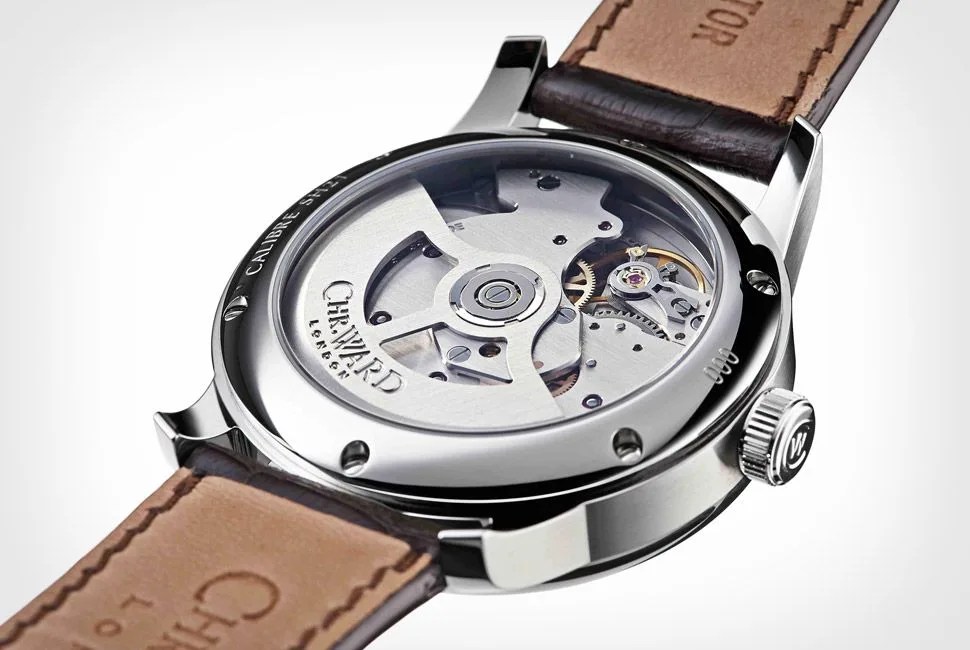Last week, while we Americans were celebrating our independence from England, English brand Christopher Ward was celebrating independence of a different sort. The ten-year-old Internet watch company announced that it had created its first in-house mechanical movement, the calibre SH21, for its new C9 Harrison 5 Day Automatic timepiece. While the watch itself is a handsome piece, fitting well into Ward’s lineup of classic sports and dress watches, it’s this movement under the hood that has the watch world buzzing.
MORE TIMEKEEPING OPINIONS: The Horological State of the Union Jack | A Look at Fathers and Watches | Rolex Gets a New CEO
Designing a new movement from a blank sheet of paper is not an easy task, nor is the actual manufacturing of it, a process that requires considerable startup cost for tooling, expertise and materials; accomplishing this alone proves that CW has reached a new plane of ingenuity and prestige. But beyond that, the SH21 represents a new way of working in the industry and sets the bar high for other brands considering a similar move.
The term “in-house” is bandied about all too often these days in watch enthusiast circles, and there is a great deal of confusion about what it means exactly and how important it is. Traditionally, movement production was a specialization, just like that of cases, dials, hands and straps. Design work, some decoration, final assembly and quality control was done by the company whose name was on the dial. With the paradigm shift of the so-called Quartz Crisis of the 1970s, watch brands merged, movement makers disappeared or were absorbed by other companies and movement making became a point of pride for a select few brands who managed to ride out the nadir of interest in mechanical timepieces. The rest of the Swiss watch industry relied largely on the Grenchen-based ETA company for its movements, an arrangement that worked well for a couple of decades. But in a recent game-changing move, ETA declared that it would not be supplying movements to brands outside of the Swatch Group, which owns ETA. This spurred the industry into action again, with companies either scrambling to find other sources for movements or developing their own in-house.
More significant than all of its details is what the SH21 movement means for Christopher Ward’s future, and the future of the watch industry.
In the case of Christopher Ward’s SH21 movement, the brand tapped the expertise of Johannes Jahnke, a Swiss watchmaker who had worked on some unique complications for previous Christopher Ward timepieces. For the manufacturing, the company merged with Swiss movement specialist Synergies Horologères, Janhke’s former employer. Purists may quibble that these collaborations are marriages of convenience and not evidence of a true manufacture movement, much less a British one, but these days the watch industry is rife with partnerships and Christopher Ward has been very up front about the way SH21 came about. The fact is, this is a proprietary movement that no one else has; you can call it whatever you want.
Origins aside, the SH21 is not merely a basic three-hand movement modeled after an ETA 2824, which would have been the easy route for Christopher Ward. First of all, it has a 120-hour power reserve, thanks to twin mainspring barrels. Most movements in watches that compete with Christopher Ward have power reserves around 40 hours, meaning if you take it off on Friday, you’ll be winding it up before you strap it on Monday morning. Secondly, the SH21 is chronometer-certified. Chronometer certification is not uncommon these days but it is still a mark of quality and shows a level of commitment from a watch brand since each movement must be submitted individually for testing and must achieve a high level of accuracy. Finally, and perhaps most significantly, the SH21 costs around $2,000. While that seems like a lot of money to some, it is actually on the affordable end of mechanical watches, and an unheard of price point for an in-house chronometer with a 120-hour power reserve.
